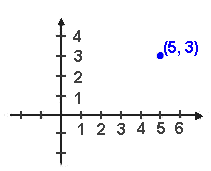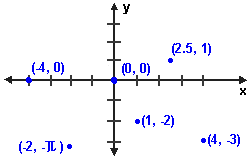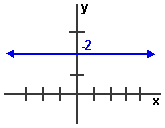Describe the Basic Concepts and Terminology?
Somebody tells you that x = 5 and y = 3. "What does it all mean?!" you shout. Well here's a picture:

This picture is what's called a Cartesian graph. It has two intersecting lines (called axes) which are usually labeled "x" and "y". Every point on the plane can be described by a pair of numbers: its x-coordinate and its y-coordinate. The x-coordinate of the point shown is 5, because the point is 5 units along the x-axis. The y-coordinate is 3. Put these together, and we can label the point "(5,3)." (Note that the x-coordinate always comes first.)
Because the picture showed the point (5,3), we call it a graph of the point (5,3). Usually, we don't merely graph a single point. Here's a graph of the set of points

Here's a graph of the set of all points with y-coodinate 2:
This set of points can be written (using standard set notation) as {(x,y): y =2}.

However, instead of the cumbersome phrase "the graph of the set of points {(x,y): y =2}", we usually just say "the graph of the equation y = 2."